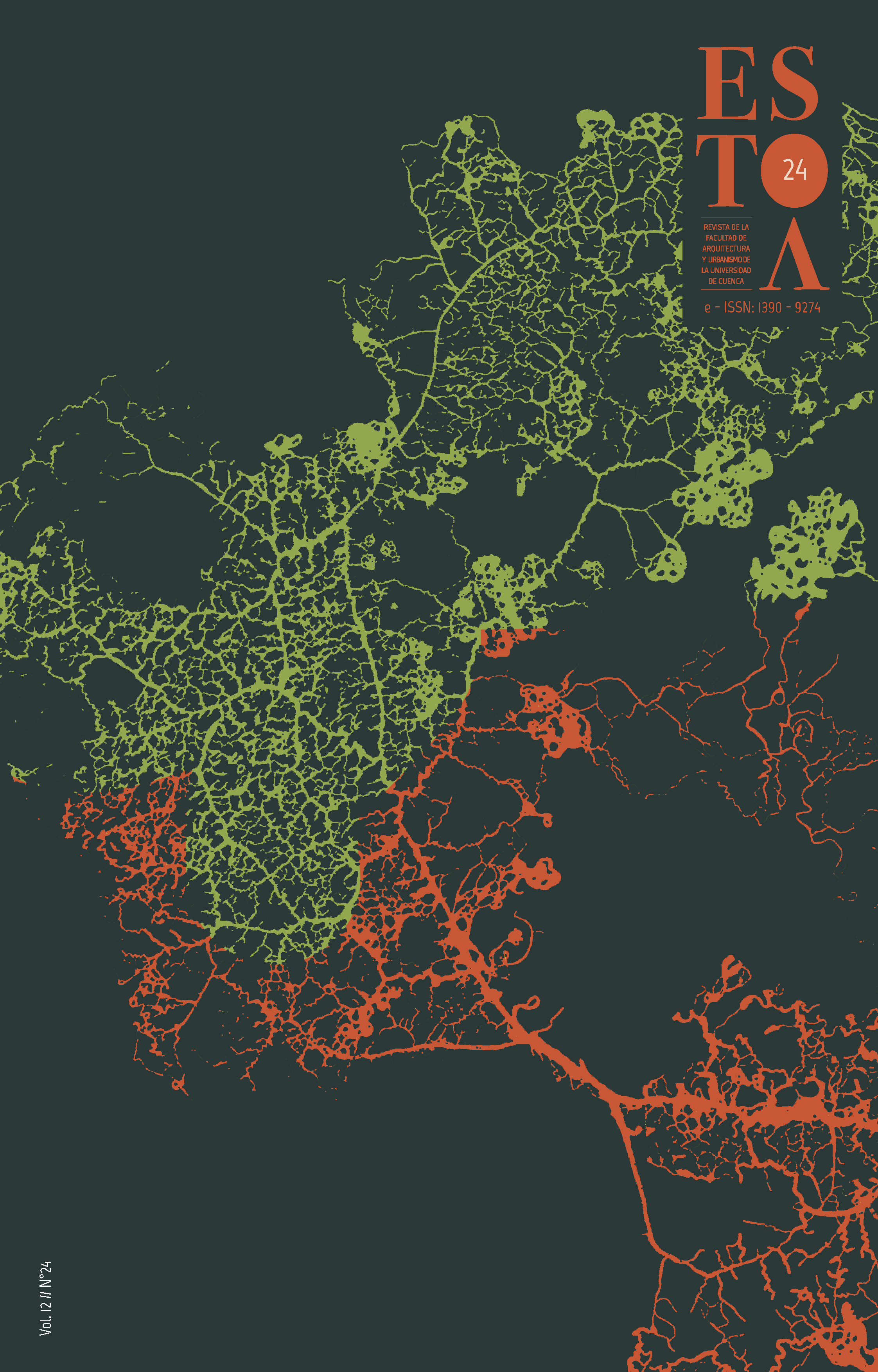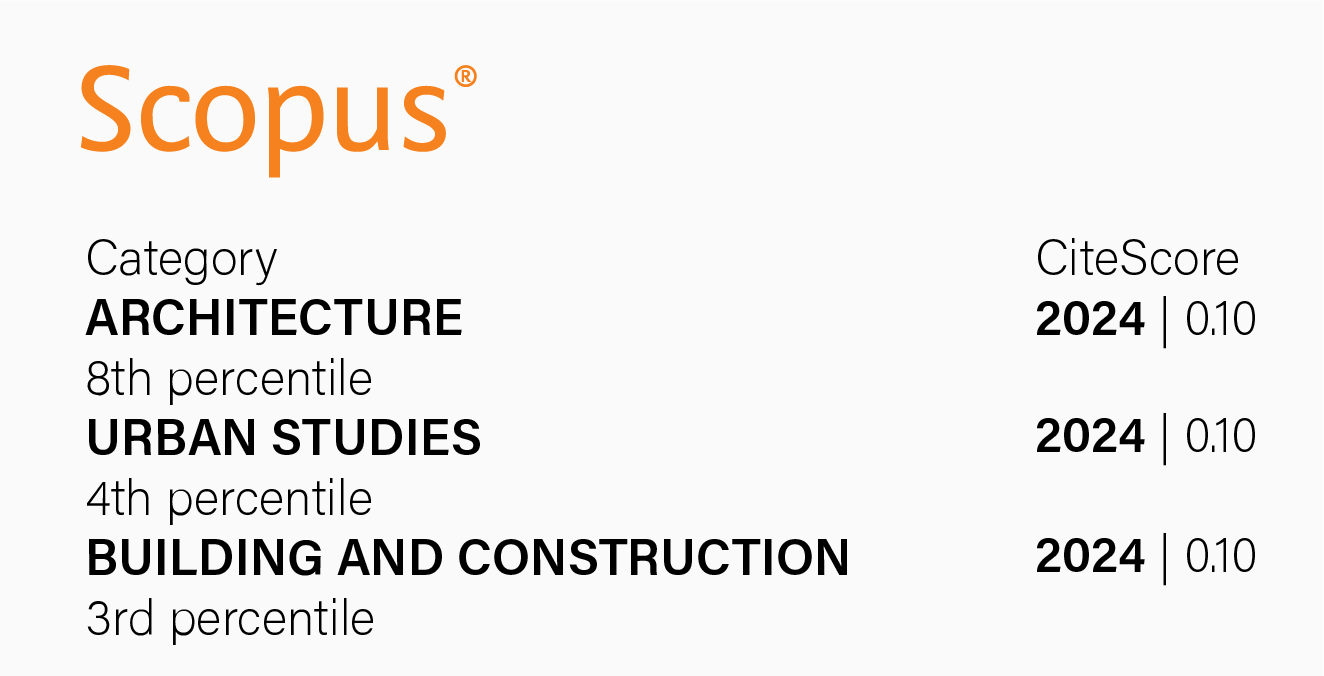Indicators of Environmental Assessment and gender. Pilot proposal for social housing in arid zone: San Juan as a case study
DOI:
https://doi.org/10.18537/est.v012.n024.a09Keywords:
indicators, gender perspective, environmental evaluation, social housing, arid zoneAbstract
In response to Sustainable Development Goals 5 and 11, the Gender Perspective is introduced and valued in the environmental analysis of Social Housing in the Arid Zone. For this, the Argentine physical-environmental, economic and social situation is contextualized and weighted, the data matrix of an internationally recognized environmental evaluation methodology. The resulting Contextualized Data Matrix is reviewed according to the variables: Mobility, Work and Care. From the use of the Hierarchical Analytical Process, the developed matrix is weighted. Finally, an Environmental Indicator (AI) and a Global Gender Indicator (IG) are built. From its application to 4 case studies, located in the city of San Juan, it is obtained that the usual construction practice, with a GI of 26.78 points and an AI of 60.23, are below the maximum possible score in the order of 34.22% and 40% respectively.
Downloads
References
Ali, H. H., y Nsairat, S. F. (2009). Developing a green building assessment tool for developing countries - Case of Jordan. Building and Environment, 44(5), 1053-1064. https://doi.org/10.1016/j.buildenv.2008.07.015
Agencia Española de Cooperación Internacional para el Desarrollo – AECID (2015). Guía de la AECID para la Transversalización del Enfoque de Género.
Álvarez, A. A. y Buigues-Nollens, A. F. (2018). Caracterización y diagnóstico de metodologías internacionales y Normas IRAM para la evaluación ambiental edilicia de la vivienda: Análisis dirigido a la contextualización regional para zonas áridas de Argentina. Revista Hábitat Sustentable, 8(1), 42-53. https://doi.org/10.22320/07190700.2018.08.01.04.
Alyami, S. H. y Rezgui, Y. (2012). Sustainable building assessment tool development approach. Sustainable Cities and Society, 5, 52-62. https://doi.org/10.1016/j.scs.2012.05.004
Beebeejaun, Y. (2017). Gender, urban space, and the right to everyday life. Journal of Urban Affairs, 39(3), 323-334. https://doi.org/10.1080/07352166.2016.1255526
Bencivenga, R., Leone, C. y Siri, A. (2021). Gender equality, diversity, and inclusion in academia: successes and failures of the initiatives promoted by the European Union. Geopolitical, Social Security and Freedom Journal, 4(1). https://doi.org/10.2478/gssfj-2021-0003
Buchely, L. F., Castro M. V., Arias-Arévalo S. y Pinzón M. R. (2021). La movilidad urbana de las mujeres en dos ciudades colombianas: entre el trabajo de cuidado y la violencia sexual. Revista INVI, 36(102), 109-126. https://doi.org/10.4067/S0718-83582021000200109
Buckingham, S., Perello, M. y López-Murcia, J. (2021). Gender mainstreaming urban waste reduction in European cities. Journal of Environmental Planning and Management, 64(4), 671-688. https://doi.org/10.1080/09640568.2020.1781601
Butcher, M. (2020). Feminist City: Claiming Space in a Man-made World. Gender & Development, 28(3), 658-660. https://doi.org/10.1080/13552074.2020.1832387
Carpio-Pinedo, J., De Gregorio-Hurtado, S. y Sánchez de Madariaga, I. (2019). Gender Mainstreaming in Urban Planning: The Potential of Geographic Information Systems and Open Data Sources. Planning Theory & Practice, 20(2), 221-240. https://doi.org/10.1080/14649357.2019.1598567
Ciocoletto A. (2014). Espacios para la vida cotidiana. Auditoría de Calidad Urbana con perspectiva de Género. Col•lectiu Punt 6. https://www.punt6.org/wp-content/uploads/2022/04/libro_Espacios-para-la-vida-cotidiana_ES.pdf
Consejo Nacional de Coordinación de Políticas Sociales (2019). Agenda 2030 para el Desarrollo Sostenible. Lenguaje Claro. www.derechofacil.gob.ar
Esquivel, V. y Sweetman, C. (2016). Gender and the Sustainable Development Goals. Gender & Development, 24(1), 1-8. https://doi.org/10.1080/13552074.2016.1153318
Flores-Sánchez F. y Olvera-Mejía T. (2021). Seguimiento, Medición y Evaluación de los Objetivos de Desarrollo Sostenible en los Gobiernos Locales en México. Revista Inclusiones, 8, 41-58. https://www.revistainclusiones.org/index.php/inclu/issue/view/142
Fondo de las Naciones Unidas para la Infancia - UNICEF. (2017). Comunicación, infancia y adolescencia: Guías para periodistas. https://www.unicef.org/argentina/media/1516/file/Perspectiva%20de%20g%C3%A9nero.pdf
Fresnillo-Sallan, I. (2020). Debt and climate: entangled emergencies derailing women’s rights and gender justice. Gender & Development, 28(3), 499-513. https://doi.org/10.1080/13552074.2020.1838168
Horelli, L. (2017). Engendering urban planning in different contexts – successes, constraints and consequences. European Planning Studies, 25(1), 1-18. https://doi.org/10.1080/09654313.2017.1339781
Huning, S. (2020). From feminist critique to gender mainstreaming — and back? The case of German urban planning. Gender, Place & Culture, 27(7), 944-964. https://doi.org/10.1080/0966369X.2019.1618796
Kim, S., Yang, I., Yeo, M. y Kim, K. (2005). Development of a housing performance evaluation model for multi-family residential buildings in Korea. Building and Environment, 40(8), 1103-1116.
Méndez, A. C. (2016). Género y arquitectura. Una perspectiva desde lo conceptual. Conversando con Zaida Muxí. Arquitectura y Urbanismo, XXXVII(1), 71-76.
Mendoza, A., Solano, C., Palencia, D. y García, D. (2019). Aplicación del proceso de jerarquía analítica (AHP) para la toma de decisión con juicios de expertos. Ingeniare. 27(3), 348-360. http://dx.doi.org/10.4067/S0718-33052019000300348.
Nadin, V., Stead, D., Dąbrowski, M. y Fernández Maldonado, A. (2021). Integrated, adaptive and participatory spatial planning: trends across Europe. Regional Studies, 55(5), 791-803. https://doi.org/10.1080/00343404.2020.1817363
Nerio-Monroy, A. (2019). ABC de la Perspectiva de Género y las Masculinidades. Comisión Nacional de los Derechos Humanos. México. https://www.generoymetodologias.org/media/publicaciones/archivos/ABC-de-las-masculinidades.-CNDH.-2019.pdf
Organización de las Naciones Unidas (2018). La Agenda 2030 y los Objetivos de Desarrollo Sostenible Una oportunidad para América Latina y el Caribe. ONU. https://www.cepal.org/es/publicaciones/40155-la-agenda-2030-objetivos-desarrollo-sostenible-oportunidad-america-latina-caribe
Ortiz-Escalante, S. y Gutiérrez-Valdivia, B. (2015). Planning from below: using feminist participatory methods to increase women’s participation in urban planning. Gender & Development, 23(1), 113-126. https://doi.org/10.1080/13552074.2015.1014206
Osorio Gómez, J. y Orejuela Cabrera, J. (2008). El proceso de análisis jerárquico (AHP) y la toma de decisiones multicriterio. Ejemplo de aplicación. Scientia Et Technica. XIV(39), 247-252.
Paredes-Herrera M. y Viteri-Uzcátegui M. (2018). Certificación Energética «Verde» para Multiresidenciales en El Ecuador. Ciencias, Medio Ambiente y Diversidad, 55-82.
Parra-Martínez, J., Gutiérrez-Mozo, M. E., Gilsanz-Díaz, A. (2021). Inclusive Higher Education and the Built Environment. A Research and Teaching Agenda for Gender Mainstreaming in Architecture Studies. Sustainability, 13(5), 2565. https://doi.org/10.3390/su13052565
Quesada-Molina, F. (2018). Desarrollo de nuevos métodos de Evaluación Sustentable de la edificación a partir de la revisión del Estado del Arte. ACE: architecture, city and environment, 13(37), 51-70. http://dx.doi.org/10.5821/ace.13.37.4871
Quintanilla, C. (2022). Enfoque de Género y Apropiación del Espacio Público. Revista Crítica Urbana, V(23). https://criticaurbana.com/critica-urbana-23-urbanismo-feminista
Ramstetter L. y Habersack, F. (2020). Do women make a difference? Analysing environmental attitudes and actions of Members of the European Parliament. Environmental Politics, 29(6), 1063-1084. https://doi.org/10.1080/09644016.2019.1609156
Rositas-Martínez, J. y Mendoza-Gómez J. (2013). El Proceso Analítico Jerárquico (AHP) como Método Innovador en la Toma de Decisiones Grupales. XVII Congreso Internacional en Ciencias Administrativas. UNIVA.
Sánchez-de Madariaga, I. y Zucchini, E. (2020). Movilidad del cuidado en Madrid: nuevos criterios para las políticas de transporte. Ciudad y Territorio Estudios Territoriales, 52(203), 89–102. https://doi.org/10.37230/CyTET.2020.203.08
Sandberg, L. y Rönnblom, M. (2016). Imagining the ideal city, planning the gender-equal city in Umeå, Sweden. Gender, Place & Culture, 23(12), 1750-1762. https://doi.org/10.1080/0966369X.2016.1249346
Tapia-Gómez, M. (2022). Urbanismo feminista para no feministas. Revista Crítica Urbana, V (23), 3. https://criticaurbana.com/wp-content/uploads/2022/03/00.-CU23_Tapia.pdf
Torres-Pérez, M. (2021). Habitabilidad de la vivienda mínima y las ciudades en pandemia mundial: COVID-19 en Mérida, México. Revista INVI, 36(102), 352-383. https://doi.org/10.4067/S0718-83582021000200352
Uribe-Tami M. (2014). La Morfología Urbana de la Vivienda Social en Colombia. Teoría, Historia y Proyecto. 174-179. https://upcommons.upc.edu/bitstream/handle/2099/14922/174_179_Mar%C3%ADa_Fernanda_Uribe_Tami.pdf
Uribe-Tami, M. (2019). La calidad como objetivo. Propuesta metodológica. Bitácora Urbano Territorial, 30(1), 167-179. https://doi.org/10.15446/bitacora.v30n1.70139
Valdivia-Gutiérrez, B., Ciocoletto, A., Ortiz-Escalante, S., Casanovas, R. y Fonseca-Salinas, M. (2017). Entornos habitables. Auditoría de seguridad urbana con perspectiva de género en la vivienda y el entorno. Col·lectiu Punt 6. https://www.punt6.org/es/books/entornos-habitables/
Vargas, R. (2010). Utilizando el Proceso Analítico Jerárquico (PAJ) Para Seleccionar y Priorizar Proyectos en una Cartera. Articles. https://ricardo-vargas.com/articles/analytic-hierarchy-process-es/
Published
How to Cite
Issue
Section
License
Copyright (c) 2023 Estoa. Revista de la Facultad de Arquitectura y Urbanismo

This work is licensed under a Creative Commons Attribution-NonCommercial-ShareAlike 4.0 International License.
The Journal declines any responsibility for possible conflicts derived from the authorship of the works that are published in it.
The University of Cuenca in Ecuador conserves the patrimonial rights (copyright) of the published works and will favor the reuse of the same ones, these can be: copy, use, diffuse, transmit and expose publicly.
Unless otherwise indicated, all contents of the electronic edition are distributed under a Creative Commons Attribution-NonCommercial-ShareAlike 4.0 International License.




